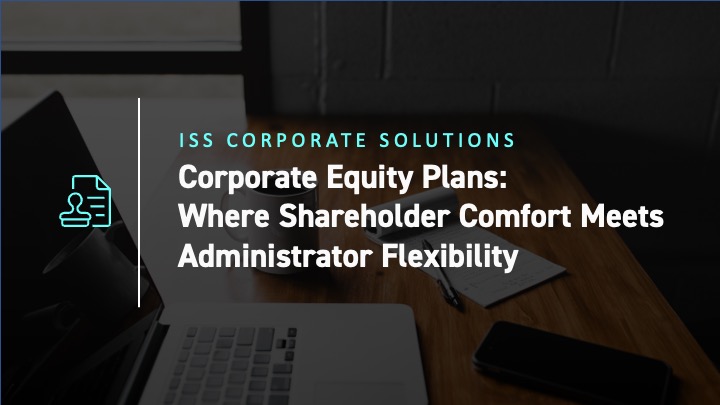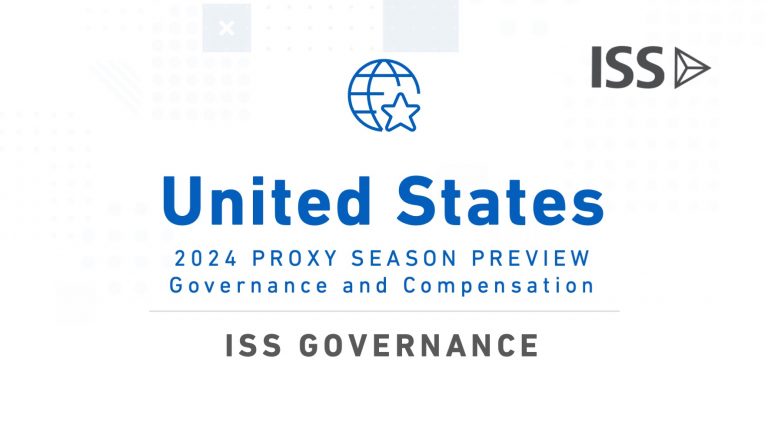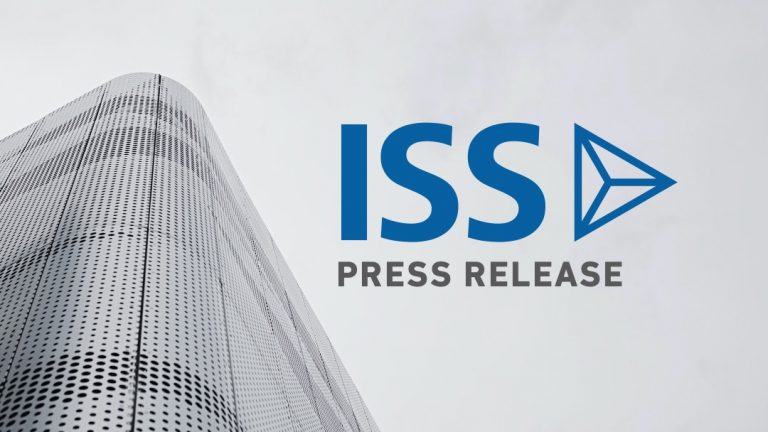A well-managed corporate equity plan is always a balance between assuring shareholders that their interests are protected and giving management the flexibility it needs to serve the interests of all stakeholders, such as attracting and retaining top talent. The ISS Equity Plan Scorecard (EPSC), now in its eighth year, considers equity governance and how administrators achieve both these priorities.
The ESPC’s examination of equity governance features helps companies consider how they can successfully give more comfort to shareholders over the use of plan shares without sacrificing that flexibility. One effective place to achieve this is in the minimum period required for full vesting of an equity award. Many companies already actively employ a minimum vesting period, often enacted through provisions included in the award agreements. These arrangements allow the plan administrator to deal with certain events – such as granting like-for-like termed replacement grants for newly-hired NEOs – without going to shareholders for approval each time.
There are a number of ways to give investors the comfort they want in equity plan administration that still allow the administrators the flexibility to deal with special circumstances, such as the aforementioned NEO hiring example. A great place to start is with a minimum period for full vesting. Most companies stipulate a minimum vesting period of a certain number of years from the date of grant of an award where the minimum criteria apply. While these vesting requirements apply to all award types as stipulated in the plan, some plans allow for a carve-out for a certain number of shares where these restrictions do not apply and the administering committee may establish lesser restrictions or none at all. Typically, the carve-out applies to 5% of the shares authorized for issue. An extract from such a plan provision based on public filings is shown below:
“Minimum Vesting Requirements: The Amended Stock Plan mandates a minimum one-year vesting period for all awards (other than converted awards) granted thereunder, except that up to 5% of the shares available for grant may be made subject to awards that do not have such a minimum vesting requirement. The minimum vesting requirement does not apply to substitute awards or to awards granted to non-employee directors which vest on the earlier of the one-year anniversary of the date of grant and the next annual meeting of the Company’s shareholders (provided such next annual meeting is at least 50 weeks after the immediately preceding year’s annual meeting). The minimum vesting requirement does not prevent the Company from granting awards that contain rights to accelerated vesting on a termination of employment or service or otherwise accelerating vesting, as provided in the Amended Stock Plan.” Source: DEF 14A SEC Corporate Issuer Filings search.
Carve-out provisions give the administering committee much needed flexibility to handle various situations as they arise. For example, it may be necessary to provide a grant with little or no restrictions as a sweetener to attract a new hire. A different situation might call for shorter vesting periods to accommodate like-for-like replacement grants for a newly hired executive.
Another place where shareholder comfort and administrator flexibility intersect is on the topic of post-exercise/post-vesting shareholding requirements. Some administering committees think of holding periods as fixed time periods necessary to attain minimum ownership levels. In that view, a company may specify that a newly hired or promoted executive has a certain number of years to attain the ownership levels that are set. If an executive officer fails to meet that target, he/she may be required to hold a minimum of the net shares resulting from any future vesting of equity-based awards until the minimum ownership guidelines are met. Through this approach, holding periods can be used as a vehicle to accelerate the attainment of minimum ownership levels.
Shareholders and proxy advisors alike appreciate approaches that foster closer alignment with management. After all, equity-based incentives are intended to help align the interests of management and shareholders and enhance long-term value, something that mayy be undermined if executives immediately dispose of all or most of the shares received.
Therefore, administering committees have flexibility to adopt palatable alternatives like 12-month post-exercise or post-vesting holding period or hold-to-end of employment/retirement policies which in turn translate into a longer-term view on stock price performance that would be welcomed by shareholders. While there are variations in how holding periods can be set, the underlying theme is that they provide a way for plan administrators to satisfy shareholders. An extract of such post vesting holding based in public filings is below:
“The Stock Ownership Policy also requires all individuals covered under this policy, including named executive officers, to retain 50% of the net shares resulting from the vesting or earning of all RSAs, restricted stock unit awards, performance awards or similar awards granted on or after June 1, 2018, and 50% of the net shares resulting from the exercise of all stock options, stock appreciation awards or similar awards granted on or after June 1, 2018, for a period of twelve months following the applicable vesting, earning or exercise date. This retention requirement applies even after the applicable thresholds of ownership described above are satisfied.” Source: DEF 14A SEC Corporate Issuer Filings search.
These two equity administration tools are related to different pillars of the EPSC framework. Minimum vesting requirements factor into the “Plan Features” pillar, while post-exercise/post vesting requirements factor into the “Grant Practices” pillar. If you would like to discuss possible ways to make equity compensation governance work for your organization, please contact your ICS Representative.
By: Chan Pedris, Executive Director, ISS Corporate Solutions




